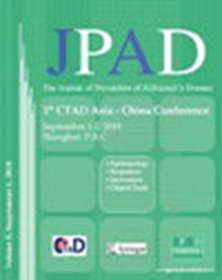Editorial: The 'Aducanumab Story': Will the Last Chapter Spell the End of the 'Amyloid Hypothesis' or Mark a New Beginning?
IF 7.8
3区 医学
Q1 CLINICAL NEUROLOGY
引用次数: 0
“Aducanumab故事”:最后一章是“淀粉样蛋白假说”的终结还是标志着一个新的开始?
Budd Haeberlein,s.,Aisen,P.,Barkhof,F.等人在最新一期《阿尔茨海默病杂志》上发表的题为“Aducanumab治疗早期阿尔茨海默病的两项随机3期研究”的论文[https://doi.org/10.14283/jpad.2022.30]介绍了两项备受期待的关键试验的结果,以证明aducanumab作为早期阿尔茨海默病[AD]的治疗方法的安全性和有效性。这项3期研究表明,AD的分子成像和生物流体标记物的减少与认知能力下降的减缓有关。这些结果于2021年6月获得了美国食品药品监督管理局的加速批准,这是基于该药物对替代终点的影响,即“。。。合理地预测对患者的临床益处…”(1) 。这一“有条件”的监管裁决需要进一步的验证性[第四阶段]试验,以验证药物对替代终点的影响实际上预测了临床意义的益处。EMA(在欧盟)和CMS(在美国)随后的决定不利于该药物治疗痴呆症的常规临床应用。美国食品药品监督管理局、欧洲药品管理局和CMS的这些具有里程碑意义的监管决定引发了争议,引发了激烈的辩论:两项关键试验的方法论缺陷、科学合理性存疑、替代标志物与认知功能之间的关联性弱、高治疗成本的财务影响以及最终临床效用的不确定性;等待对患者具有临床意义的益处的验证(2)。不管关于aducanumab的监管裁决和临床优点的争论中的各种立场如何,重要的是公布第一个3期试验的结果,以显示替代标记物与痴呆行为/临床特征之间的假定关联。这项研究以及随后的“有条件”监管决定,是40年来开发有效的痴呆症干预措施的重要“教学”里程碑。关于科学中有争议问题的激烈辩论并不是一个新现象,也不一定对进步有害。例如,近三十年前,关于第一种获批用于AD的药物Tacrine的研究和监管裁决也存在争议。[DOI:10.177/1060002809402800612]。该研究受到方法学问题的困扰;不良事件[re:肝毒性]在试验完成前停止,在目前的情况下,美国食品药品监督管理局关注结果测量的充分性/有效性/相关性。最终,到2013年,由于其临床意义有限的益处以及对其与肝脏毒性的联系的担忧,Tacrine[Connex]退出了市场。但是,在AD的治疗发展史上,他克林是一个重要的“教学事件”。回想起来,他克林经验的一个重要方面是,美国食品药品监督管理局将批准的监管障碍要求设定在“恰到好处”的水平,这可能是关于aducanumab有条件批准的利弊的辩论中的情况。30年前,如果美国食品药品监督管理局对他克林的“监管标准”设定得太低,就会鼓励开发大量疗效可疑的垃圾治疗方法。另一方面,更高的“监管门槛”会阻碍基于胆碱能假说的替代假定干预措施的进一步研发。现在,FDACMS关于aducanumab的两项监管决定可能是完全批准的“恰到好处”的监管障碍要求。在“故事”的最后一章中,事实证明他克林不是一种理想的药物,但它的遗产为进一步研究改良药物铺平了道路。因此,关于aducanumab的好消息是,[即使从长远来看,它未能实现成为首选治疗药物的承诺],美国食品药品监督管理局的有条件批准已经为这类药物的进一步研发投资创造了一个令人鼓舞的环境。但是,坏消息是aducanumab面临的挑战是,需要强有力的令人信服的证据[例如,巨大的药物效应(3)]来验证有条件批准的监管前提;即假设©Serdi和Springer Nature Switzerland AG 2022
本文章由计算机程序翻译,如有差异,请以英文原文为准。
求助全文
约1分钟内获得全文
求助全文
来源期刊

Jpad-Journal of Prevention of Alzheimers Disease
CLINICAL NEUROLOGY-
自引率
7.80%
发文量
85
期刊介绍:
The JPAD « Journal of Prevention of Alzheimer’Disease » will publish reviews, original research articles and short reports to improve our knowledge in the field of Alzheimer prevention including : neurosciences, biomarkers, imaging, epidemiology, public health, physical cognitive exercise, nutrition, risk and protective factors, drug development, trials design, and heath economic outcomes.
JPAD will publish also the meeting abstracts from Clinical Trial on Alzheimer Disease (CTAD) and will be distributed both in paper and online version worldwide.
 求助内容:
求助内容: 应助结果提醒方式:
应助结果提醒方式:


